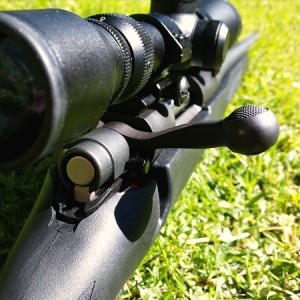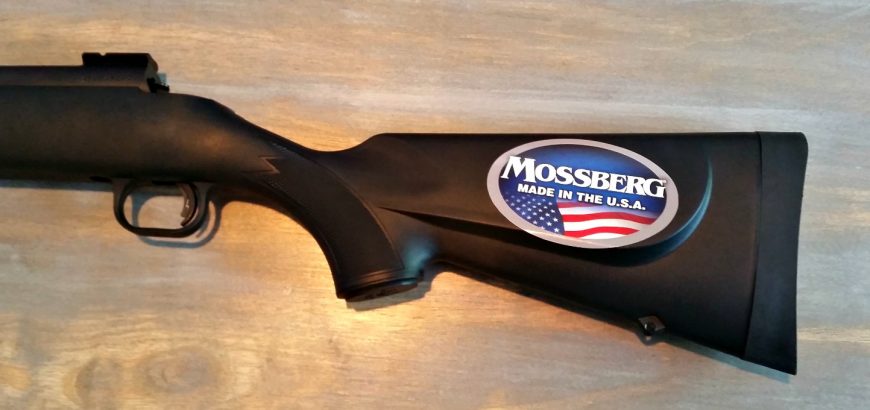The Mossberg 100 ATR gets its initials from the phrase ‘All Terrain Rifle’. To be honest, if that’s what you’re after, this fits the bill. An inexpensive rifle that is rough and ready, but with a couple features that do stand out, the ATR is not a glamorous 1000-yard shooter, but a simple hunting tool.
Affordability is…
I do a fair bit of reading and research when it comes to shooting, and I remember one thought that really stood out when reading on barrel metallurgy. While steel prices have increased noticeably over the last decade, rifle prices have remained relatively static. So, if the cost of raw material is increasing, how are prices not rising accordingly?
This can be partly answered with advances in manufacturing techniques and the use of polymers and synthetics in place of wood and other expensive materials. However, it can’t be ignored that even some of the most expensive rifles show a bit more roughness around the edges compared to their 80’s or 90’s ancestors.

Mass production has resulted in cheaper rifles, while some advances in tooling, assembly and technique have resulted in relatively consistent levels of accuracy.
The Mossberg ATR is the ultimate expression of these cost-saving measures. It has the features you want, and some extras that you’ll enjoy – but it does feel cheap.
On the plus side
Undeniably, the most positive thing about this rifle is its price point. It’s affordable enough for the beginner hunter to make their way into the sport, and even cheap enough for the seasoned shooter to justify buying one just to try a different calibre out.
The ATR has been around for a fair few years, and has been supplanted in the States by the Patriot series of rifles – which seems to be a step up from the old ATR. However, with quite a bit of stock floating around New Zealand, there are still plenty of brand new rifles and packages floating around. You can expect to get a rifle for around $600 – $700, and packages including mounting system, rings, a scope and possibly a couple extras for between $700 and $900. A few good examples are here, here and here.
Features abound

Working in its favour, the Mossberg has a few features that you would expect to see on a more expensive firearm. Some that immediately spring to mind are the easily adjustable trigger, half cock on the bolt, side safety, a slick feeding action and fluting on the barrel.
- LBA – Lightning Bolt Action – trigger system. The trigger on the ATR is fully adjustable, down to a mere 2 pounds. I found the 3 pound trigger pull from the factory to be light enough, especially for a hunting rifle, and even let one round off a bit too soon, as I expected more resistance from such a stock-standard rifle. Similar in appearance to the Savage Accutrigger, the LBA has a a thin piece of steel that nestles into the centre of the trigger. It’s pretty light and wiggly, but behind that is a rock solid single-stage trigger. The effect is similar to a two-stage trigger as the blade locks up the sear until fully depressed.
- The half cock feature is something that a lot of hunters like. it allows you to be chambered and ready to go, with a simple push down on the bolt when you sight your prey. I personally prefer a bolt closed on an empty chamber, but the half cock is undeniably popular. The side-safety is easily reachable and operable, without shifting from your shooting position. You can easily manipulate it with the thumb of your shooting hand, but again, this isn’t something that is make-or-break for me.
- The action is smooth as butter. In fact, probably one of the smoothest bolt actions in my safe. With two locking lugs and only a negligible bit of wobble when it travels, the bolt is well balanced. It’s a push-feed (as are most modern rifles), and picks up its rounds easily enough. I would buy this rifle all over again simply because it is so easy to work and feed.
- The fluting on the barrel is a nice touch, and makes the rifle appear a bit more classy than its price tag would indicate. Aside from that, I can’t see much use for it. The weight saving couldn’t be too much, given it’s only have the barrel. And to be honest, this rifle could use a tiny bit more weight to absorb some recoil. However, it does make you feel less cheap when you’re at the range sighting in next to a Howa or a Remmy 700.
- Already equipped with Weaver-style bases, the rifle is ready to mount your favourite scope too. It seems the bases are loctited too, as after over 50 rounds, these didn’t work loose. It’s also worth pointing out that the drop on the stock is pretty near perfect, lining you up nicely with a low-mounted scope.
It’s not all candy floss and daisies
It would be great to say we’ve found the cheapest, bestest rifle in the world. But you know how it goes. Cheap, accurate, reliable – choose two.
There are some aspects to the rifle that don’t float my boat, but at the incredibly low price, these are things I can generally handle. This rifle will end up being a good short-range (100 – 300 yards) shooter, for taking out goats, pigs or deer that present themselves nicely. It won’t be my go-to rifle, nor will it be my trusty long-range shooter.
Here are some of the detractors, which limit the rifle’s appeal in my opinion. Some of these are down to cheaper manufacturing, and can be expected.
- It’s noisy. The ATR has a flimsy plastic stock that is hollow. If you knock the butt of the rifle, it lets out a hollow clunk. When you close the bolt you can hear it riding over the plastic follower and the bolt handle lets out another hollow-sounding tone when closed against the side of the stock.
- The floor metal is… plastic. If you go for the walnut stock, you’ll get proper floor metal. However, the synthetic version comes with plastic moulded sling mounts, trigger guard and blind-magazine floor plate, I say floor plate, but it is completely sealed and inaccessible from the bottom of the rifle. This will all limit your ability to swap out the stock at a later date (without buying floor metal), and may interfere with some mounted accessories, such as bipods.
- The recoil is dramatic. The 7mm-08 is not known to be a heavy recoiling round, however, with no mass to absorb the backward motion of the action, most of that recoil is going straight into your shoulder. Even with the inch-thick recoil pad equipped, there was noticeable kick. I did have a light grip on the fore of the rifle on the first shot I took, and after copping a scope to the face, I quickly tightened up my grip to arrest the rearward motion of the firearm. The walnut stocked version will probably deal with this recoil more appropriately.
- The look of it. To be honest, it’s not that bad, and as mentioned above, the fluted barrel helps in the looks department. However, the obnoxious Mossberg branding on the bolt looks like lipstick on a pig. Without it, it would look like a good, basic rifle. Rather than a tarted-up cheapy.

Accuracy and the deal-breaker
I decided to test this basic hunting rifle with basic hunting loads. A week ago I took a drive down to Waiuku Pistol Club and spent some time on the 100 yard range testing out the following cartridges:
- Winchester 140 gr Super-X Power Point
- Remington 140 gr Express Core-Lokt
- Highland AX 140 gr SPBT
- Hornady 139 gr American Whitetail
I have read a few other reviews on this rifle, and note that one reviewer achieved sub-minute groups with some expensive ammo, while another was happy enough with his 2+ MOA groups.

This is the realm my rifle was printing in. The average group size across all four brands (3-shot groups) was 2.53 MOA. Surprisingly, the budget brand Highland AX achieved the best groups, just over 2 MOA, while Winchester (favoured by many 7mm-08 shooters) achieved just under 3 MOA.
At the end of the day, a 2 or 3 MOA rifle at this price is about what you would expect, and is still delivering consistent kill shots out to 300 yards (if you’re using a load closer to the 2 MOA range).
And I could forgive many aspects of this rifle’s construction if it ended there. The very tilty magazine follower, the hollow stock, the spartan looks and short length-of-pull.
All of this could be forgiven, if the barrel fouled a little during break in.
Barrel with no fouling
I know breaking in a rifle barrel is an oft-debated topic, but here it is, I do practice barrel break-in, especially for cheaper rifles, which stand to gain the most from a bit of polishing in the bore to relieve some rough machining. The process I use has nothing to do with achieving X amount of shots, cleaning in between each Y amount of shots. Rather, I take a similar approach to what Nathan Foster describes here. Visually inspecting for copper fouling, and masking sure you are getting a nice, slow build up, which will help maintain accuracy over a decent amount of shots, before fouling becomes excessive.
Two things that can indicate poor barrel manufacturing are excessive fouling after each shot, or no fouling at all. The latter is what I experienced with the ATR. After putting through 51 rounds, not a single trace of copper was seen. Plenty of powder residue, but no hint of the lands hugging the bullet enough to produce some slight copper swaging.
What does this mean? The bore is slightly over-sized. So slight, almost imperceptible. But it makes a massive difference. This barrel will never achieve a sweet spot after a few fouling rounds. The first clean shot will always be the best, and it will only go downhill from there until it is cleaned. Not only this, but the wear on the lands will mean that it has a greatly reduced barrel life, maybe 5 – 20% of what you would expect from your average barrel.
I’m certainly not saying that every ATR is like this. I am saying that this one is. While yours may be great, mine is a shocker. It will be good enough for casual goat hunts, where you might be using between 2 and 10 rounds in a trip. It will probably be good enough for at least a dozen or so trips like this. However, after this, the gun will rapidly start to lose accuracy and usefulness. Not having an action worth re-barrelling, in a few years, this particular rifle will not be worth much at all. However, given the price I paid for it, I feel like I will have achieved sufficient use out of this firearm in that time to justify the expense (and then some).
It’s also been a treat to be able to buy a cheap rifle simply to try out the 7mm-08 calibre. A more thorough review of the ammo used will be coming up soon.
Final thoughts?
If you want a cheap shooter in a new calibre, something to throw on the quad to take around the farm, or an inexpensive bush gun that can take some knocks, the All Terrain Rifle lives up to its name. If you’re under any allusions as to buying cheap and shooting 1/3 MOA groups all day, think again. You may luck out and get a great barrel, you may not.
At the end of the day, the rifle is worth every cent you pay for it, and a little bit more.



























